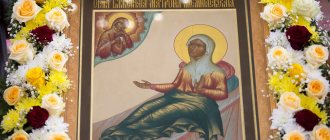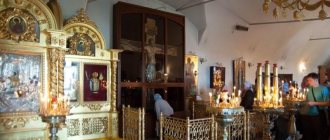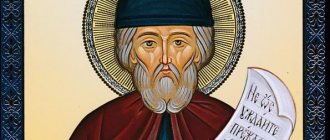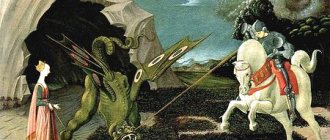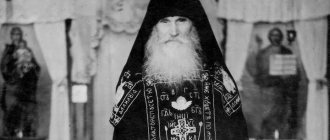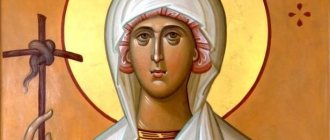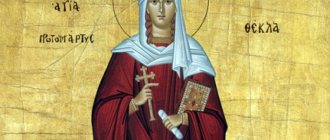From the biography of St. Sampson the Host
Sampson the Host was born in Rome. His family was rich and famous. The monk received an education worthy for that time and achieved especially high results in the art of healing. His patients, for the most part, were poor and poor people, whom Sampson the Stranger treated completely free of charge. He understood that charitable deeds are carried out with a deep Christian upbringing, so he prayed a lot and diligently read the Holy Scriptures.
Sampson the Stranger. Fresco (Photo from logoslovo.ru)
When Sampson the Host's parents died, he distributed all his inheritance to the poor. So he put into practice the advice about perfection that the Savior gave to the rich young man (Matthew 19:21). He chose the path of asceticism for himself. He granted freedom to the slaves and went into the desert. Here he intended to take on the feat of a strict ascetic lifestyle. But the Lord decreed differently.
By the Will of God, Sampson the Host ended up in Constantinople. He settled in a small house, where he conducted medical appointments for wanderers and poor patients. There he treated people with great love and attention and performed acts of mercy.
Excerpt characterizing Sampson the Stranger
“Now I feel good,” she said and, asking me to start, got to work. Prince Hippolyte brought her a reticule, walked behind her and, moving a chair close to her, sat down next to her. Le charmant Hippolyte [Charming Hippolyte] struck with his extraordinary resemblance to his beautiful sister and even more so because, despite the resemblance, he was strikingly bad-looking. The features of his face were the same as those of his sister, but with her everything was illuminated by a cheerful, self-satisfied, youthful, unchanging smile of life and the extraordinary, antique beauty of her body; his brother, on the contrary, had the same face clouded with idiocy and invariably expressed self-confident grumpiness, and his body was thin and weak. Eyes, nose, mouth - everything seemed to shrink into one vague and boring grimace, and arms and legs always took an unnatural position. – Ce n'est pas une histoire de revenants? [This is not a ghost story?] - he said, sitting down next to the princess and hastily attaching his lorgnette to his eyes, as if without this instrument he could not begin to speak. “Mais non, mon cher, [Not at all," the surprised narrator said, shrugging his shoulders. “C’est que je deteste les histoires de revenants, [The fact is that I can’t stand ghost stories,” he said in such a tone that it was clear that he said these words, and then realized that they meant. Because of the self-confidence with which he spoke, no one could understand whether what he said was very smart or very stupid. He was in a dark green tailcoat, trousers of the color cuisse de nymphe effrayee, [thighs of a frightened nymph,] as he himself said, stockings and shoes.
How Sampson the Host helped Emperor Justinian I
In those distant times, Byzantium was ruled by Emperor Justinian I (527 - 565). It so happened that he became seriously ill. Skilled court doctors could not help the emperor. Justinian cried out to God with a burning prayer. And soon he saw a dream in which a person was shown who could heal him. An order was given to find a doctor. The servants had to go around the whole city to find Sampson the Stranger. The doctor was taken to the imperial palace. As soon as Sampson touched the sore spot, Justinian was healed. The emperor was filled with gratitude. He offered a lot of gold and silver. But the monk refused. True, he asked to build a hospice house and a hospital. This request was immediately fulfilled by Justinian. Moreover, estates were assigned to these institutions for their maintenance.
Reverend Sampson the Host served people until a very old age. He died peacefully and painlessly around 530. The body of the monk was buried in a church in the name of the holy martyr Mofia.
Strong prayer to the holy Reverend Sampson for well-being
no comments
The Reverend Sampson the Host is quite unfairly little known in Russia, despite the fact that he is a great Christian saint. Prayer to Saint Sampson helps to get rid of illnesses, find a roof over your head, and gives consolation in sorrows. The monk received such grace from God for his holy life and great desire to help people. The future saint was born in Rome and came from a rich and noble family. Thanks to this, he was able to receive an excellent education and study to become a doctor. However, the holy Venerable Sampson the Host directed his mind and knowledge not towards his own enrichment, but towards free service to his neighbors. Left an orphan, he distributed all his wealth to those in need, and went to serve God in Constantinople. There he opened a shelter for the poor, where he provided them with a roof over their heads and treated them without charging for it. Soon the rumor about Sampson's miraculous prayers spread throughout the surrounding area, and the local patriarch ordained him as a priest.
Miracles after prayer to St. Sampson
For the great feat of serving his neighbors, God gave Sampson the gift of healing prayer, and he was able to heal people not only with the help of his skill, but also by praying for them. One day the dying Emperor Justinian called the saint to him for treatment.
Saint Sampson prayed and laid his hands on the sore spot, after which the illness began to leave the emperor. In gratitude for his health, Justinian wanted to reward him generously, but he refused, asking the emperor to sponsor the construction of a hospital for the poor. And the emperor fulfilled his request, and the rest of St. Sampson spent the rest of his work caring for and developing his brainchild.
Christian prayer to Saint Sampson
After the death of Saint Sampson in 530, miracles began to occur near his relics. Prayers to Reverend Sampson helped people get rid of serious illnesses. There is a known case when a certain Theodoret, who served at the emperor’s court, fell and injured his leg. The leg was very painful and caused serious suffering to the patient.
Then Theodoret began to read a prayer to Saint Sampson, and three days later he appeared to him in a dream. After that, his leg no longer bothered him. Modern Christians can also pray to this great healer, who had no equal in his love for his neighbors. Orthodox priests do not recommend buying icons in unverified places, since the image on them may differ significantly from the canonical one, so it is better to buy an icon of St. Sampson in an Orthodox online store, icon shop, or monastery. Needlewomen can embroider an icon with beads or using some other technique.
Watch the video about the life of the Holy Venerable Sampson the Host
Read the text of the Orthodox prayer to St. Sampson
O warm prayer book, Blessed Father Reverend Sampson! Pray to God for me, the present one, and send down help and deliverance from the All-Blessed Master, for my life is temporary and full of work, sorrows and illnesses.
Strengthen my heart, so that I can bear my burden, and do not let me, so that my many small strengths will overcome temptations, but help me with your intercession and, in the midst of circumstances and troubles, direct my path to the Kingdom of Heaven, so that I may glorify the Lord who is glorified in you forever. Amen
Troparion, Tone 8
In your patience you have gained your reward, Reverend Father, in your prayers you are unceasingly patient, loving the poor and satisfied with this, but pray to Christ God, the merciful Blessed Sampson, to save our souls.
Kontakion, Tone 8
As a doctor of all kinds and a favored prayer book, flowing to your Divine race, O reverend Sampson the God-Wise, coming together with love, psalms and songs, rejoicing, we glorify Christ, giving you such grace as healing.
Two versions of biography
There are two versions of the life story of the mysterious old man. The first can be found on his official website, created by the monk's followers. The second takes its origins from archival references and documents and almost completely contradicts the first.
27
June
2021
The future hieroschemamonk, in the world Sivers Eduard Yakovlevich, was born in Petrograd.
His father was listed as a collegiate assessor, but later Hieromonk Sampson would insist on his parent’s count origins and his personal friendship with Emperor Nicholas II. Despite his baptism in the Anglican Church, the boy gravitated towards Orthodoxy: he visited churches on his own, was interested in monastic life, and in 1917 he received holy baptism with a name in honor of St. Sergius of Radonezh.
According to the official version, he worked at the Kryletsky Monastery in Pskov, where he arrived for the purpose of novitiate. But he was soon arrested and sentenced to death, which was carried out on the holiday of the Intercession. He received a bullet wound and a severe concussion - wounds, the consequences of which would haunt the monk all his life. Survived. At night, the monks pulled his body out from under the pile of dead, and, dressing him in the uniform of a Red Army soldier, sent him to his mother.
The interrogation protocol from 1932 recorded other data. At the age of 18, the young man became a volunteer for the Red Army and was wounded in the battles near Gatchina. After which he was demobilized with a white ticket to Petrograd, where he underwent eight operations. Gangrene and sepsis almost took his life, but doctors managed to save Sievers. He practically turned into a disabled person: his arm worked at a quarter of its normal capacity. In addition, Sievers suffered from neurosis all his life.
The young man was sent to the city of Tikhvin for rehabilitation. While still in the hospital, Sivers applied to join the Communist Party and even served for some time as an assistant to the district military commissar. But then, having strengthened his faith, he renounced membership in the All-Union Communist Party (Bolsheviks) and became a subdeacon. Under the patronage of the Bishop of Tikhvin, he entered the Alexander Nevsky Lavra, where he became a monk and was given the name Simeon.
In 1935, Sievers was arrested for resisting the so-called renovationists - a newly formed church structure completely loyal to the power of the Soviets. Sievers served his three-year sentence in the NKVD Svirlag, and not in Solovki, as stated in his official biography. After his release, he was ordained to the rank of hieromonk. This event took place ten years later than the date stated by the elder himself.
A year later, Sivers was expected to be arrested again on charges of anti-Soviet propaganda. During interrogations, the hieromonk denied everything, but exhausted by threats, difficult conditions of detention and worsening illness, he could not stand it: he gave out the names of everyone who gathered in his apartment. Sievers spent six months in the dungeons of the NKVD, writing nine statements in which he renounced his priesthood.
From a written appeal dated August 10, 1936 addressed to the head of the regional sector of the NKVD:
“I resign from the title and profession of a minister of religious worship, I repent of my act of reckless stubbornness and myopia, having once become one.”
At the end of the investigation, Sievers was sentenced to forced labor camps for a period of 8 years.
Since 1946, he served in various parishes in Stavropol and Mordovia, then, with the support of Archbishop Sergius (Larin), he received a position as a priest in the Kazan Cathedral in Stalingrad. Commissioner for Religious Affairs Kositsyn gave an extremely unflattering description of Sivers, accusing the latter of mysticism, careerism and hinting at too partial attention to women in confessions.
Among the fairer sex, Sivers gained popularity as a miracle healer, capable of casting out demons. Many girls and women from different regions of the Soviet Union came to the monk, which ultimately resulted in a major public scandal.
On May 22, 1958, the local newspaper “Stalingradskaya Pravda” published the feuilleton “Two Lives of Father Simeon,” in which the author accused the priest of fornication. The basis for writing the article was a letter from Sivers himself, addressed to a certain Anna Kozolupova. “Everything, unction, confession, and ... sexual intercourse,” Bishop Sergius writes with horror in his report to the patriarch, was mixed up in the vile procedure.
The bishop, who had given Sivers protectorate in the past, was now forced to hastily conduct an internal investigation. Under pressure from the letter and circumstantial evidence, Father Simeon confessed that he:
“used the Holy Sacrament of Penance for the vile purposes of involving women in cohabitation with himself, and even in an unnatural way.”
As punishment, the hieromonk was exiled to the Odessa monastery and banned from serving for 15 years. Fate clearly favored Sivers: despite the actual renunciation of the rank and repeated conflicts with the leadership, he still remained in business. According to the 62nd Apostolic Canon:
“If any of the clergy, out of fear of a man, a Jew or a Greek, or a heretic, renounces the name of Christ: let him be rejected from the church. If he renounces the name of a minister of the church: let him be expelled from the clergy. If he repents, let him be accepted as a layman.”
However, the ban on serving for Sivers was not final: it had a period after which the hieromonk could be reinstated in church communion as a cleric, and not a layman. Of course, 15 years is a considerable period of time for a 60-year-old man, but the priest managed this period incorrectly. He was again accused of seducing a parishioner and expelled from the monastery.
According to another version, Bishop Sergius sent the elder to the Pskov-Pechersk Monastery, where Sivers was concerned about attracting young people to Orthodoxy. This allegedly caused discontent among the party elite, and the leadership of the monastery was forced to send the elder away.
Three years after these events, Sievers arrives in Moscow and leaves the state. And a year later he takes the schema and is named Sampson.
